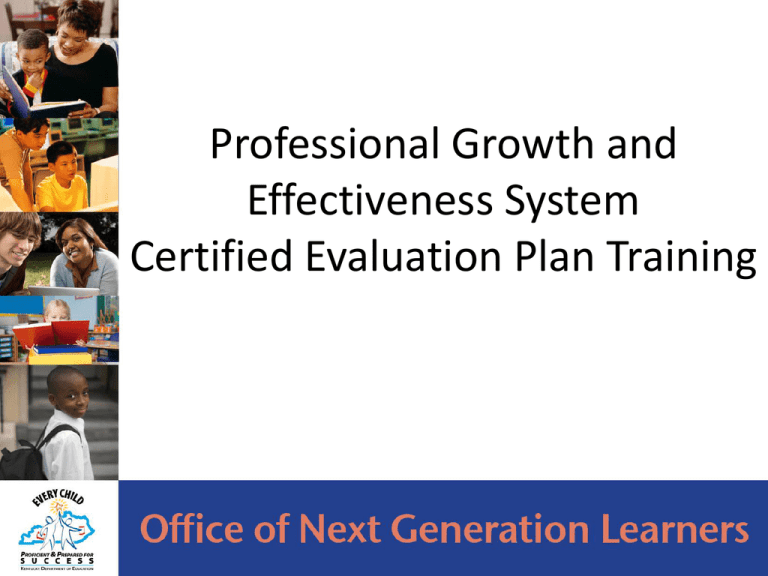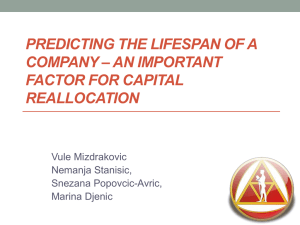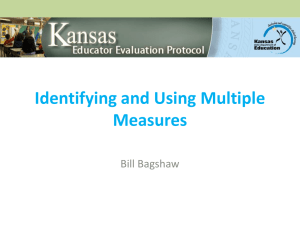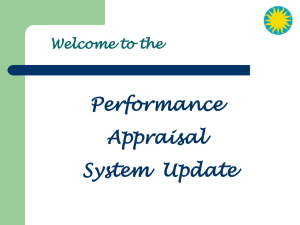PowerPoint - Jenny Ray
advertisement

Professional Growth and Effectiveness System Certified Evaluation Plan Training 5 • Understand how to guide the district evaluation committee (50/50 committee) in revising the current district Certified Evaluation Plan (CEP) to assure the plan meets the requirements of the Professional Growth and Effectiveness System (PGES). FOCUS: PROCESS PROCEDURE Agenda Introduction • Professional Growth Plan/Self-Reflection • Observation • Student Voice Lunch • Student Growth • Overall Rating • Principal Professional Growth and Effectiveness • Next Steps Current CEP PGES Model CEP PGES Checklist Expertise of 50/50 Committee PGES Consultants KLA/ISLN 5 Model Certified Evaluation Plan • Guidance provided for 50/50 committee to revise CEP and fulfill requirements of PGES • Required and Local Decisions are stated • Examples are provided in the Appendix 5 Evaluation Committee (50/50 Committee) Personnel Decisions for the 2014-15 school year Preschool, Other Professionals, and KTIP Pilot Systems Capacity Building Connect TPGES to PPGES throughout the day CEP Submission 5 Teacher Professional Growth and Effectiveness System 5 PROFESSIONAL PRACTICE KENTUCKY PROFESSIONAL GROWTH AND EFFECTIVENESS MODEL SOURCES OF EVIDENCE TO INFORM PROFESSONAL PRACTICE See MINIMUM CRITERIA FOR DETERMINING AN EDUCATOR’S PROFESSIONAL PRACTICE RATING DOMAIN RATINGS Observation Student Voice Professional Growth Plans and Self Reflection Other: DistrictDetermined PROFESSIONAL JUDGMENT & INSTRUMENTS STUDENT GROWTH SOURCES OF EVIDENCE TO INFORM STUDENT GROWTH State Contribution – Student Growth Percentiles (SGPs) • State-Defined High/Expected/Low • 3 Year of Data AND DOMAIN 1: Planning and Preparation DOMAIN 2: Classroom Environment DOMAIN 3: Instruction DOMAIN 4: Professional responsibilities GROWTH PLAN AND CYCLE PROFESSIONAL JUDGMENT & STATEDETERMINED DECISION RULES GROWTH PLANNING MATRIX PROFESSIONAL JUDGMENT & DISTRICTDETERMINED DECISION RULES Local Contribution – Student Growth Goals (SGGs) • District-Defined High/Expected/Low • 3 Year of Data KDE:ONGL:FCS:TB:011814 PROFESSIONAL PRACTICE RATING PERCENT (%) EFFECTIVE TEACHERS PROFESSIONAL JUDGEMENT AND STATEDETERMINED DECISION RULES STUDENT GROWTH TREND RATING (H/E/L) OVERALL PERFORMANCE CATEGORY See MINIMUM CRITERIA FOR DETERMINING AN EDUCATOR’S OVERALL PERFORMANCE CATEGORY 9 Informing Professional Practice 5 Reflects on current growth needs Collaborates with administrator to develop the PGP and action steps Implements the plan Regularly reflects on progress and impact Modifies the plan as appropriate Continues implementation and ongoing reflection Conducts summative reflection Realistic Focused Measurable Multiple Sources of Data Classroom Observation Feedback Student Growth/Achievement Self-Assessment Reflection • Instructional Planning • Lesson Implementation • Content Knowledge • Beliefs • Dispositions Monitored through Pre-determined Methods Articulated as Specific Goals Organized PGP Outcomes of Self-Reflection Contextualize in a Support Framework (pg. 5 ) Explain the expectations for developing a Professional Growth Plan (PGP) and ongoing Self-Reflection. What is the process for teachers to input the PGP and Self-Reflections into CIITS? 5 5 Use the same instruments Supervisor observation will provide documentation and feedback for teacher effectiveness (SUMMATIVE RATING) Peer observation will only provide formative feedback (NO SUMMATIVE RATING) OPTION A OPTION B OPTION C One full observations by the supervisor that is the final observation in the summative year Three mini observations with one being by the peer observer during the summative year. Two full observations by the supervisor with one of the full observations being the final observation in the summative year. Two mini observations with one being by the peer observer during the summative year. Provide an explicit description of the observation model Assure that this option provides at least a minimum of 4 observations in the summative cycle (3 principal/1 peer) Discuss with your team the observation model that would work best for your district. What changes would need to occur in order for this model to be implemented? Would the observation model fulfill the criteria for PGES? 5 Districts will provide conferencing requirements for their teachers and observers. ◦ Pre and Post conference after each full observation but not mini ◦ Pre conferences may be completed electronically ◦ Post conferences may be completed in person ◦ May not require pre conferences Districts may choose timeline for observation schedule. Example only 1st Observation: Begins 30 days after the start of school 2nd Observation: Begins November 1 3rd Observation: Begins December 15 4th Observation: Begins February 15 (All observations should be concluded by April 1) At your table , look at your current CEP plan and discuss with your team What are you currently doing that would meet the observation requirements? Conferencing? (PRE/POST) Timeline? Plan for 50/50 Committee Evaluators must complete the Teachscape Proficiency Observation Training Three sections: Framework for Teaching Observer Training Framework for Teaching Scoring Practice Framework for Teaching Proficiency Assessment Test divided into two stages If a stage is not passed on the first attempt, must wait 24 hours before retaking Year 1 Certification Year 2 Calibration Year 3 Calibration Year 4 Certification Teachscape, the current approved technology platform, must be used for certification and calibration. If a supervisor has yet to complete – or does not pass – the proficiency assessment, the district must provide supports: ◦ Processes/procedures to ensure success during the first assessment administration ◦ Supports for those who do not pass If the supervisor is not certified through the proficiency system, the district will use the following processes/procedures: ◦ May include district-level personnel or principals from another building (certified through the proficiency system) ◦ Will conduct the observation with the principal (modeling the process) Discuss with your team how the district will support Observation Certification and procedures to maintain certification. 5 All teachers will be observed by a trained Peer Observer during the summative year. All Peer Observers participating during the summative year observations will complete the state developed training. District decisions: ◦ Number of peer observations required each evaluation cycle (minimum of 1 during the summative year) ◦ Processes and procedures the district will use to ensure all teachers have access to Peer Observers ◦ Documentation that Peer Observers have met selection and training requirements Selection/Assignment at the District Level Examples include: NBCT Cadre Content Specialists Selection/Assignment at the School Level Examples include: Teacher Leaders Selection/Assignment at the Teacher Level Examples include: Trusted Peers PLC Team Members pool selected at the district pool selected at the pool self-selected at level, school level, the school level, assigned to assigned to teachers teachers select their teachers/schools at the at the school level, own Peer Observer district level, or or may simply be a pool of may simply be a Peer Observers from which pool of Peer schools/teachers may Observers from choose which teachers may choose Talk about Peer Observers * Selection and Training * Number of Peer Observations * Peer Observation Model Identify an Observation Model Determine Observation pre/post conference protocol Develop Observation Schedule Observation Certification • Procedures • District Support Peer Observers • Selection and Training • Number of Peer Observations • Peer Observation Model 5 Student Voice Survey Guide Please refer to Student Voice Survey Guide for complete details. 5 The Superintendent of each district will assign a point of contact to be responsible for overseeing and administering the Student Voice Survey meeting Ethics Requirements The district point of contact will be responsible for the general and administrative, processes for ensuring Student Voice produces results for teachers in their district. The District will determine the number of sections required per teacher to participate in the survey. Participating teachers must have a minimum of one section respond to the survey Building Principals will determine the section(s) participating in the Student Voice Survey. The student voice survey coordinator will work to ensure that all classes participating in the survey have computers with Internet access. For teachers who work in collaborative classrooms, there are several scenarios as to how their students may be surveyed. Students with ELL, IEPs, 504 Plans will receive requisite supports to ensure equal access. District Decisions Identify the Point of Contact Determine the number of sections per teacher Develop a plan to provide accommodations to students for equal access. 5 Student Growth 5 Student Growth Percentiles The state contribution for student growth is base on KDE state assessment data. Teachers of Grades 4-8, reading and mathematics Rating based on each student’s rate of change, compared to academic peers Median SGP for a teacher’s class is compared to that of the state Measures progress for students at all performance levels Student Growth Goals The local contribution for the student growth measure is a rating based on the degree to which a teacher meets the growth goal for a set of students over a specified period of time as indicated in the teacher’s Student Growth Goal (SGG). All teachers, regardless of grade level and content area, will develop SGGs for inclusion in the local student growth measure. of Student Growth Goals Rigor means congruency to the standards. Sources of Evidence True intent of the Standards Congruent with KCAS grade level and content Enduring skills, understandings, processes or concepts Allows all students to demonstrate knowledge and growth The district must include the degree to which the goal and the assessments meet the SGG criteria. OPTION A: Rigor Rubric OPTION B: Peer-Review and/or Jury Process OPTION C: District-Defined Option The [peer-review] [jury] process will be used by all teachers prior to final approval of the SGG. Vertical content-area PL Teams Grade-level PL teams District-Level Content Coaches Multi-District Content-Area Teacher Teams Must include an explanation to ensure rigor. Processes, procedures, protocols, etc. must include the input of teachers and administrators in the district. There must be evidence of the research base grounding an instrument. Literacy Design Collaborative teachers (LDC) (any content area) For the 2011 – 12 school year, 100% of students will make measurable progress in writing. Each student will improve by one performance level in three or more areas of the LDC argumentation rubric. Furthermore, 80% of the students will score a “3” or better overall. Discuss with your team the required number of SGGs for teachers . Describe the process for determining rigor of SGG. 5 Student Growth Goals Teachers agree on what it looks like for students to meet a given standard or group of standards. Assessments are appropriate for students to show that they meet the intent of the standard Assessments may be different in structure, even when assessing the same standards. Administration Protocol Scoring Process SAMPLE Assessment Design Process Professional Learning Teams— Analyze ◦ standards ◦ assessments ◦ student work and other student data Work with your team to describe how comparability of SGG and Assessments will be met. 5 Single Student Growth Goal SMART process for goals Options for rating low, expected or high growth: Pre-Test/Post-Test Repeated Measures Design Holistic Evaluation Assessment over content standards Assessment over content standards Same assessment over content standards Identical Assessments Comparable Assessment over content standards Comparable Assessments Assessment Assessment Assessment Assessment Assessment Assessment over content over content Assessment over content Assessment over content over content Assessment over content standards standards Assessment standards over content standards over content standards over content standards Assessment over content standards standards standards over content standards standards Teacher & Principal analyze formative assessment data Trends and patterns Determine growth over time Combining pre- and post-test model with repeated measures Use of district-developed “growth rubric” for a holistic evaluation Districts must explain the processes and procedures for ensuring quality and inter-rater reliability of the rubrics. Assessments must meet the district assurance of rigor and comparability. • Pre-Test/Post-Test • Repeated Measures Design • Holistic Evaluation Collaborative process of data analysis using aCalculation district-developed rubric Collaborative process data analysis using usingofcut scores a district-developed rubric & calculated cut scores This process must be applied across all teachers and schools within the district. Discuss with your team how the district will determine high/expected/low growth 5 District Decisions Determine the number of SGGs for teachers. Ensure rigor and comparability of SGG and Assessments Determine high/expected/low growth 5 Overall Performance Rating 5 Determining the Overall Performance Category Informed by evidence, the evaluator determines the Overall Performance Category based on Professional judgment… Sources of evidence: • Domains • District-Developed Rubrics • Decision rules that establish a common understanding of performance thresholds to which all educators are held Rating Professional Practice Rating Professional Practice Scenario for Mr. Thomas • • • • • Observations Student Voice Survey Self Reflections Professional Growth Plans Other relevant local data Teacher Domain Ratings Domain 1: Prep and Planning A Domain 2: Classroom Environment D Domain 3: Instruction D Domain 4: Professional Responsibilities A Rating Professional Practice Scenario for Mr. Thomas Teacher Domain Ratings Domain 1: Prep and Planning A Domain 2: Classroom Environment D Domain 3: Instruction D Domain 4: Professional Responsibilities A • The principal must now provide ONE professional practice rating that is inclusive of all domains. • Please look at the proposed decision rules that you were given today. Decision Rules for Determining Professional Practice Domain Ranking Domain 1 Accomplished Domain 2 Developing Domain 3 Developing Domain 4 Accomplished Domain Ranking Domain 1 Domain 2 Domain 3 Domain 4 Exemplary Exemplary Accomplished Ineffective Domain Ranking Domain 1 Exemplary Domain 2 Exemplary Domain 3 Accomplished Domain 4 Ineffective Domain Ranking Domain 1 Domain 2 Domain 3 Domain 4 Ineffective Developing Developing Ineffective Option: You could leave the chart as is and leave to the discretion of the principal. Domain Ranking Domain 1 Ineffective Domain 2 Developing Domain 3 Developing Domain 4 Ineffective As a district you could decide to expand the decision rule list and create additional rules for guidance. Table Activity • At your table, discuss your options for the rating of Professional Practice. A) Add more decision rules? If so, what would they be? B) Use Evaluator’s Professional Judgment C) A combination of both A and B Overall Student Growth Rating PROFESSIONAL PRACTICE KENTUCKY PROFESSIONAL GROWTH AND EFFECTIVENESS MODEL SOURCES OF EVIDENCE TO INFORM PROFESSONAL PRACTICE See MINIMUM CRITERIA FOR DETERMINING AN EDUCATOR’S PROFESSIONAL PRACTICE RATING DOMAIN RATINGS Observation Student Voice Professional Growth Plans and Self Reflection Other: DistrictDetermined PROFESSIONAL JUDGMENT & INSTRUMENTS STUDENT GROWTH SOURCES OF EVIDENCE TO INFORM STUDENT GROWTH State Contribution – Student Growth Percentiles (SGPs) • State-Defined High/Expected/Low • 3 Year of Data AND DOMAIN 1: Planning and Preparation DOMAIN 2: Classroom Environment DOMAIN 3: Instruction DOMAIN 4: Professional responsibilities GROWTH PLAN AND CYCLE PROFESSIONAL JUDGMENT & STATEDETERMINED DECISION RULES GROWTH PLANNING MATRIX PROFESSIONAL JUDGMENT & DISTRICTDETERMINED DECISION RULES Local Contribution – Student Growth Goals (SGGs) • District-Defined High/Expected/Low • 3 Year of Data KDE:ONGL:FCS:TB:011814 PROFESSIONAL PRACTICE RATING PERCENT (%) EFFECTIVE TEACHERS PROFESSIONAL JUDGEMENT AND STATEDETERMINED DECISION RULES STUDENT GROWTH TREND RATING (H/E/L) OVERALL PERFORMANCE CATEGORY See MINIMUM CRITERIA FOR DETERMINING AN EDUCATOR’S OVERALL PERFORMANCE CATEGORY 81 Rating Student Growth Ratings will fall into one of the following three categories Low Expected High Rating Student Growth –Supervisors will look at “trend data” from three years (if available) when determining a teacher’s rating. –Districts will develop their own rubric, decision rules, or set of guidelines to determine an overall student growth rating of: Low, Expected, or High. Rating Student Growth Sample Set of Growth Data What level would this teacher rate? Why? Ms. Gilpin’s Student Growth Data State Test Local Goal 2015-2016 2014-2015 Expected Low High Expected 2013-2014 Expected Expected How Would You Rate Ms. Hoskins? Why? Ms. Hoskin’s Student Growth Data 2015-2016 2014-2015 2013-2014 State Test Low Low Low Local Goal Expected Expected Expected How Would You Rate Ms. Lee? Why? Ms. Lee’s Student Growth Data 2015-2016 2014-2015 2013-2014 Local Goal High High Low Questions to Consider • How does a teacher switching grade levels affect the data? Particularly if they are moving in or out of a testing grade. • Should the most recent data be weighted more than previous years? • What if I don’t have three years of data? • Should the state and local goals be weighted equally in the K-PREP years? Appendix C • Consider pages 44 & 45 in your Appendix (3.0) • 3 sample decision rules for multi-year SGG ratings, in order to determine 1 final rating for the cycle – Decision rules chart – Mathematical Average – Mathematical Average with Weighting applied District C Example Mr. Watts’ Student Growth Data State Test 2015-2016 2014-2015 2013-2014 Low=1 Local Goal Yearly Averages Expected=2 2/1= 2 Expected=2 3/2 = 1.5 Low=1 1/1 = 1 .50(Y1A) + .30(Y2A) + .20(Y3A) = GT .50(2) + .30(1.5) + .20(1) = GT 1 + .45 + .20 = 1.65 Final Rating? As a team, discuss the examples for determining Overall Student Growth Rating and how your district will approach making a decision to assign a rating. 5 Overall Performance Category PROFESSIONAL PRACTICE KENTUCKY PROFESSIONAL GROWTH AND EFFECTIVENESS MODEL SOURCES OF EVIDENCE TO INFORM PROFESSONAL PRACTICE See MINIMUM CRITERIA FOR DETERMINING AN EDUCATOR’S PROFESSIONAL PRACTICE RATING DOMAIN RATINGS Observation Student Voice Professional Growth Plans and Self Reflection Other: DistrictDetermined PROFESSIONAL JUDGMENT & INSTRUMENTS STUDENT GROWTH SOURCES OF EVIDENCE TO INFORM STUDENT GROWTH State Contribution – Student Growth Percentiles (SGPs) • State-Defined High/Expected/Low • 3 Year of Data AND DOMAIN 1: Planning and Preparation DOMAIN 2: Classroom Environment DOMAIN 3: Instruction DOMAIN 4: Professional responsibilities GROWTH PLAN AND CYCLE PROFESSIONAL JUDGMENT & STATEDETERMINED DECISION RULES GROWTH PLANNING MATRIX PROFESSIONAL JUDGMENT & DISTRICTDETERMINED DECISION RULES Local Contribution – Student Growth Goals (SGGs) • District-Defined High/Expected/Low • 3 Year of Data KDE:ONGL:FCS:TB:011814 PROFESSIONAL PRACTICE RATING PERCENT (%) EFFECTIVE TEACHERS PROFESSIONAL JUDGEMENT AND STATEDETERMINED DECISION RULES STUDENT GROWTH TREND RATING (H/E/L) OVERALL PERFORMANCE CATEGORY See MINIMUM CRITERIA FOR DETERMINING AN EDUCATOR’S OVERALL PERFORMANCE CATEGORY 91 Determining an Educator’s Overall Performance Category • Overall Performance Category – This is a combination of the teacher’s Professional Practice Rating AND Student Growth Rating • The Teacher Effectiveness Steering Committee (TESC) has proposed a set of MINIMUM criteria when determining the Overall Performance Category. • Refer to pages 19-21 in Model CEP 3.0 COMPONENTS FOR DETERMINING OVERALL PERFORMANCE CATEGORY MINIMUM CRITERIA FOR DETERMINING AN EDUCATOR’S PROFESSIONAL PRACTICE RATING IF… Domains 2 AND 3 are rated INEFFECTIVE THEN… Professional Practice Rating shall be INEFFECTIVE Domains 2 OR 3 are rated INEFFECTIVE Professional Practice Rating shall be DEVELOPING OR INEFFECTIVE Domains 1 OR 4 are rated INEFFECTIVE Professional Practice Rating shall NOT be EXEMPLARY Two Domains are rated DEVELOPING, and two Domains are rated ACCOMPLISHED Professional Practice Rating shall be ACCOMPLISHED Two Domains are rated DEVELOPING, and two Domains are rated EXEMPLARY Professional Practice Rating shall be ACCOMPLISHED Two Domains are rated ACCOMPLISHED, and two Domains are rated EXEMPLARY Professional Practice Rating shall be EXEMPLARY CRITERIA FOR DETERMINING AN EDUCATOR’S OVERALL STUDENT GROWTH RATING STUDENT GROWTH RATING LOW EXPECTED HIGH KDE:ONGL:FCS:TB:011814 CRITERIA Overall Rating Category Criteria MINIMUM CRITERIA FOR DETERMINING AN EDUCATOR’S OVERALL PERFORMANCE CATEGORY PROFESSIONAL PRACTICE RATING STUDENT GROWTH TREND RATING OVERALL PERFORMANCE CATEGORY High OR Expected EXEMPLARY Low ACCOMPLISHED High EXEMPLARY Expected ACCOMPLISHED Low DEVELOPING High ACCOMPLISHED Expected OR Low DEVELOPING High DEVELOPING Expected OR Low INEFFECTIVE Exemplary Accomplished Developing Ineffective Applying the Criteria… Ms. Seagraves Professional Practice Rating Student Growth Rating OVERALL PERFORMANCE CATEGORY Accomplished Expected ??? Mr. Holte Professional Practice Rating Student Growth Rating OVERALL PERFORMANCE CATEGORY Developing Low ??? Growth Planning Matrix 5 Growth Planning Matrix • Non-Tenured: – A yearly directed growth plan. • Tenured Teachers: – Growth plans and summative cycle will be based on the Growth Planning Matrix TYPE AND LENGTH OF EDUCATOR PLAN FOR TENURED TEACHERS THREE-YEAR CYCLE SELF-DIRECTED GROWTH PLAN Goal set by educator with evaluator input One goal must focus on low outcome Formative review annually THREE-YEAR CYCLE SELF-DIRECTED GROWTH PLAN • Goals set by educator with evaluator input • Plan activities are teacher directed and implemented with colleagues. • Formative review annually • Summative occurs at the end of year 3. ONE-YEAR CYCLE DIRECTED GROWTH PLAN • Goal Determined by Evaluator • Goals focus on low performance/outcome area • Plan activities designed by evaluator with educator input • Formative review at mid-point • Summative at end of plan THREE-YEAR CYCLE SELF-DIRECTED GROWTH PLAN • Goals set by educator with evaluator input; one must address low performance or outcomes. • Plan activities designed by educator with evaluator input. • Formative Review annually. ACCOMPLISHED DEVELOPING INEFFECTIVE PROFESIONAL PRACTICE RATING EXEMPLARY RATING UP TO 12-MONTH IMPROVEMENT PLAN • Goal Determined by evaluator • Focus on low performance area • Summative at end of plan LOW THREE-YEAR CYCLE SELF-DIRECTED GROWTH PLAN • Goal set by educator with evaluator input • One goal must focus on low outcome • Formative review annually ONE-YEAR CYCLE DIRECTED GROWTH PLAN • Goal Determined by Evaluator • Goals focus on low performance/outcome area • Plan activities designed by evaluator with educator input • Formative review at mid-point • Summative at end of plan EXPECTED HIGH STUDENT GROWTH TREND RATING KDE:ONGL:FCS:TB:011814 98 District Decisions Determine method for combining local student growth goal and state student growth percentile to rate overall growth as low, expected, and high Your district must establish how a teacher’s Student Growth Rating will be determined. (e.g. rubrics, decision rules, quantitatively, etc.) The decision rules that have been established are the MINIMUM requirements by the district. Your district may add additional criteria if desired. 5 Principal & Assistant Principal Professional Growth and Effectiveness System (PPGES) 5 The CEP Model Plan The PPGES Guide (Draft) The District Current CEP Plan (Confirm Plan Assurances) Two Year Cycle of the PPGES Where are we now? Review Accountability and ASSIST Goal Results & Set SGG/PGP/Working Conditions 2-year Goal End-of-Year Review with Superintendent 2013/14 Administer Summative Val-Ed Where Are you In the Cycle? Administer Formative Val-Ed 2013-14 Site-Visit by Superintendent Site-Visit by Superintendent Mid-Year Review with Superintendent Two Year Cycle of the PPGES 14/15 Review Accountability and ASSIST Goal Results & Set SGG/PGP/ & Update Working Conditions 2-year Goal End-of-Year Review with Superintendent Administer TELL SURVEY Thinking Ahead to 2014/15 2014-15 Site-Visit by Superintendent Site-Visit by Superintendent Mid-Year Review with Superintendent Roles and Definitions-Requires additional district action As you work through the Principal Professional Growth and Effectiveness section of the Model CEP, determine if there are additional definitions that your district needs to add. 1. Instructional Leadership 2. School Climate 3. Human Resources Management 4. Organizational Management 5. Communication and Community Relations 6. Professionalism Sources of Evidence to Inform Professional Practice (Standards Rating) TELL Kentucky Survey (WC GOAL) VAL-ED 360 Survey Professional Growth Plan & Self-Reflection Site Visits Sources of Evidence to Inform Student Growth (Student Growth Ratings) State Contribution –(SGGs ) ASSIST/NGL Goal Local Contribution-Based on School Needs-May parallel state contribution. Professional Practice Professional Growth Planning and Self-Reflection (No additional district action required) Site Visits (Plan Requires additional District Action) Val-ED (Plan Requires additional District Action) Working Conditions Goal (Plan Requires additional District Action) Products of Practice/Other sources of Evidence (Self-Explanatory) Assistant Principal Requirements • Professional Growth Plan and Self Reflection – Completed independent of the principal • Working Conditions Goal – Inherited from the principal • Student Growth Goals – State & Local – Inherited from the principal • Mid-Year Reviews completed by Principal • Evaluated by the Principal annually – Principal Performance Standards & Student Growth – Same summative Overall Performance Category SBDM Minutes Faculty Meeting Agendas and Minutes Department/Grade Level Agendas and Minutes PLC Agendas and Minutes Leadership Team Agendas and Minutes Instructional Round/Walk-through documentation Budgets EILA/Professional Learning experience documentation Surveys Professional Organization memberships Parent/Community engagement surveys Parent/Community engagement events documentation School schedules Other Student Growth State Contribution-Assist/NGL Goal Based on Trajectory Local Contribution-Based on School Need --may parallel state contribution At least one (1) of the Student Growth Goals set by the Principal must address gap populations. Assistant Principals will inherit the SGGs (both state and local contributions) of the Principal. NOTE: Districts will develop a rubric to measure high/expected/low growth on both goals. Exemplary Accomplished Developing Ineffective “Shall” have a minimum of a self“Shall” have a directed minimum of a growth plan directed growth plan “Shall” have a minimum of a selfdirected growth plan “Shall” have a minimum of a directed growth plan “Shall” have a minimum of a self-directed growth plan “Shall” have a minimum of a self-directed growth plan “Shall” have a minimum of a Corrective Action Plan (Evaluator Directed) Low Growth Expected Growth High Growth The Model Professional Growth and Effective System Plan should be used in conjunction with the existing Certified Evaluation Plan to meet the assurances of the Professional Growth and Effectiveness System. For the purpose of today’s activity we will discuss the critical areas of flexibility around the following PGES components: Site Visits VAL-ED TELL/Working Conditions Student Growth Did your table discuss how districts might define the protocol that will be used with Site Visits ? How many site visits will occur in your district each year (Min. 2)? If the number of site visits vary, how will the superintendent determine the number of visits per principal. How will your district address Scheduling (Process & Procedures) What is the procedure for conducting site visits? Did you include protocols for guiding discussions/questioning? Are all required criteria addressed. VAL_ED Did your table address these issues? Who is responsible for seeing to the administration (organization and management ) of the survey? Windows? When will your district administer VAL-ED? Are there more than one window? Will VAL-ED be more than every other year? How will your district use VAL-ED results? Who will see the results? Did your table address these ISSUES? TELL SURVEY # of WC Goals? How the WCG will added to ASSIST? Process for establishing the WCG Rubric? Criteria for High, Expected, or Low Growth within the Rubric? How a mid-point review will be conducted? Additional evidence that might be used? Did your table address: How many local student growth goals will the principal be required to develop? Is there a clearly defined criteria for helping principals select goals. How will district develop a plan to identify criteria for rating high/expected/low growth? If more than one goal is required how will use multiple goals to determine high/expected/ low growth )? How do you arrive at a single local SGG result? Result from a combination of professional judgment and district developed rules/rubrics Must include data form both state and local contribution Districts must describe the process and/or instrument to be used and include as an attachment to their CEP. District Decisions Site Visits Administration of Val-Ed 360 Working Conditions Goal based on TELL Survey Student Growth 5 Follow-Up Opportunities Monday, March 10– ISLN; CEP Work Session Friday, March 21— CEP Work Session On-going CEP Plan Electronic Review Considerations • Evaluation Committee (50/50 Committee) • Personnel Decisions for the 2014-15 school year • Preschool, Other Professionals, and KTIP Pilot Systems • Capacity Building • Connect TPGES to PPGES throughout the day • CEP Submission 5 Certified Evaluation Plan Submission teacherleader@education.ky.gov 5 5






